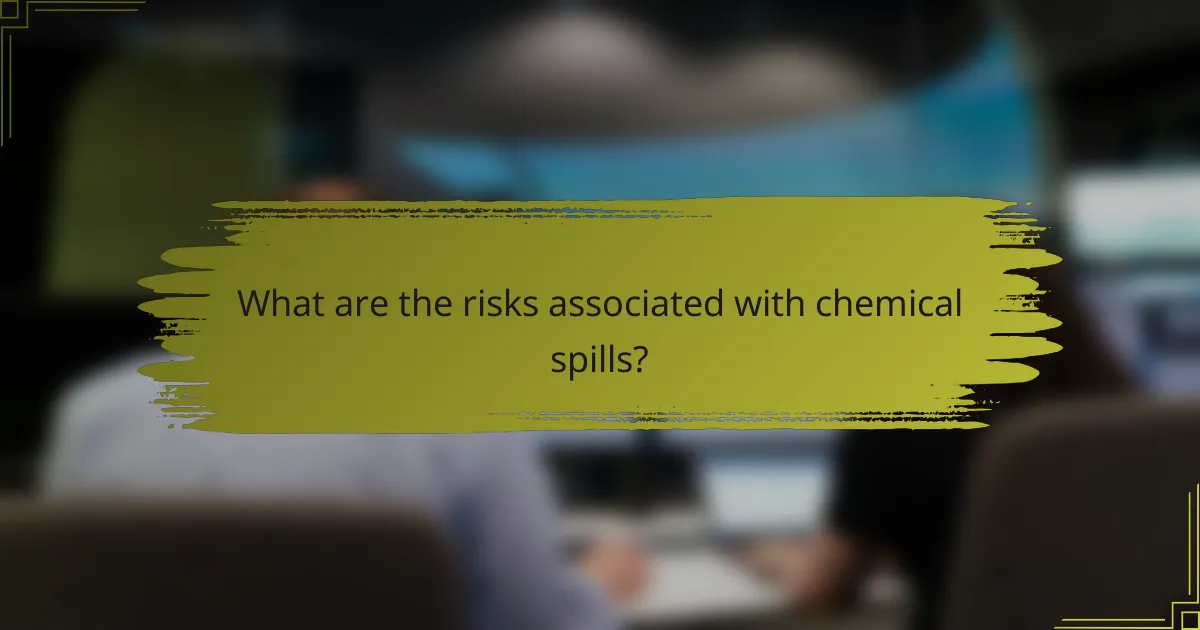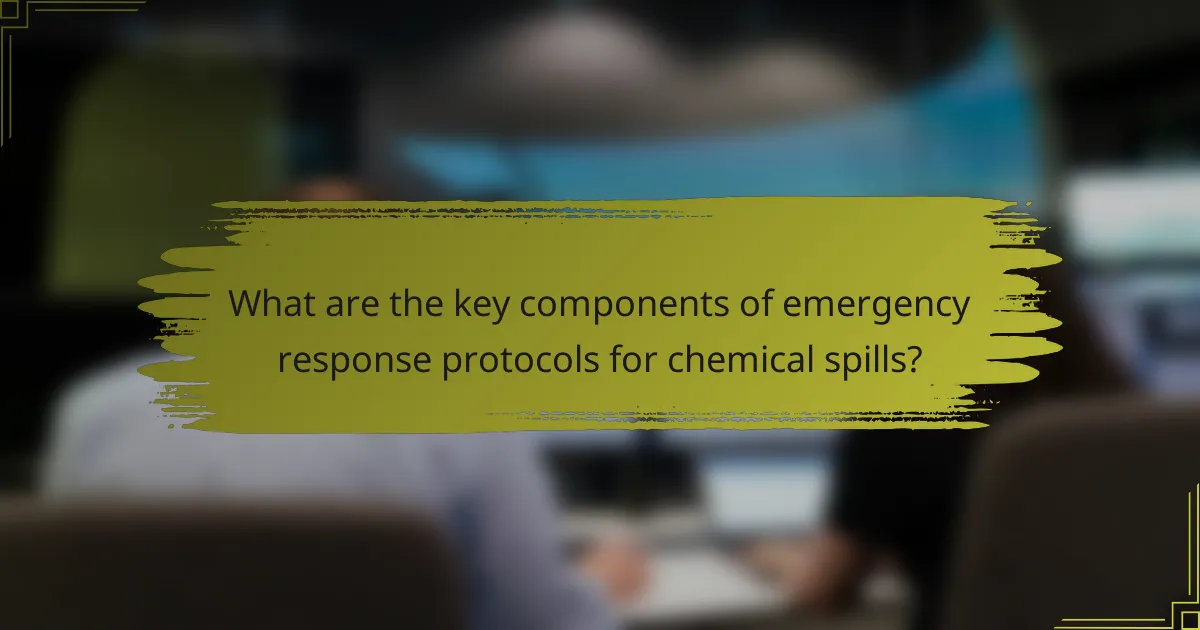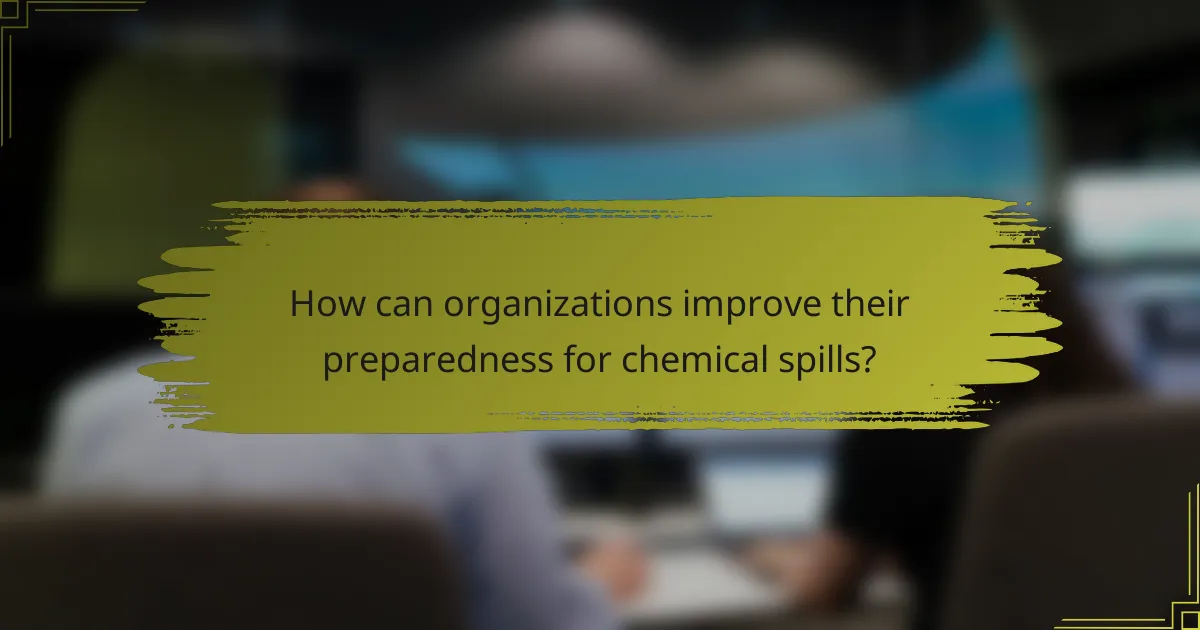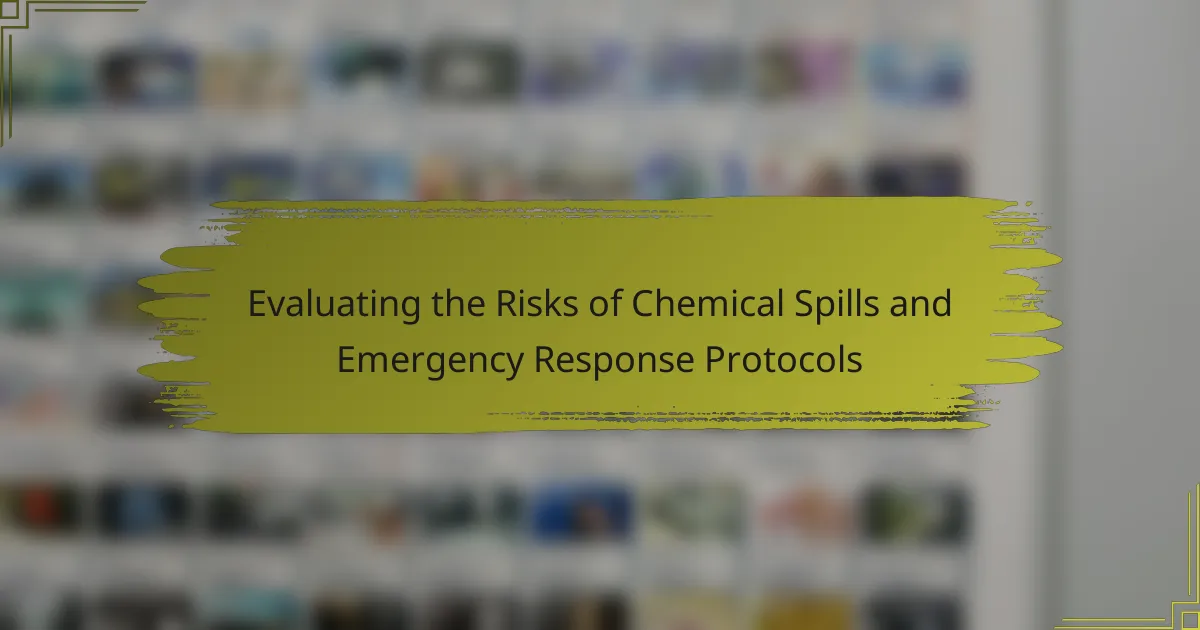
What are the risks associated with chemical spills?
Chemical spills pose significant risks to human health and the environment. They can lead to immediate health hazards, such as respiratory issues, skin irritation, and potential long-term illnesses. Exposure to toxic substances can result in acute poisoning or chronic health problems.
Environmental risks include contamination of soil and water sources. This can disrupt local ecosystems and harm wildlife. Chemical spills can also cause fires or explosions if flammable materials are involved.
The economic impact of chemical spills is substantial. Cleanup operations can be costly and time-consuming. Additionally, businesses may face legal liabilities and regulatory fines.
Overall, the risks associated with chemical spills are wide-ranging and can have lasting effects on health, the environment, and the economy.
How do chemical properties influence spill risks?
Chemical properties significantly influence spill risks by determining the behavior and impact of substances during a spill. For instance, the volatility of a chemical affects how quickly it can evaporate into the air. Higher volatility increases the risk of inhalation exposure and atmospheric contamination. Additionally, the solubility of a chemical in water dictates its potential to spread in aquatic environments. Chemicals that are highly soluble can disperse rapidly, leading to widespread contamination.
The density of a chemical also plays a crucial role. Denser liquids may sink in water, causing prolonged environmental damage to sediments and aquatic life. In contrast, lighter liquids tend to float, which can lead to surface contamination. Furthermore, the reactivity of a chemical influences spill risks. Reactive substances may undergo dangerous chemical reactions upon contact with other materials, escalating the incident’s severity.
These properties are critical in assessing spill risks and developing response strategies. For instance, a spill of a volatile, highly soluble, and reactive chemical poses a greater risk than a stable, dense, and insoluble one. Understanding these attributes helps in formulating effective emergency response protocols.
What types of chemicals are most commonly involved in spills?
The most commonly involved chemicals in spills include petroleum products, hazardous waste, and industrial chemicals. Petroleum products often consist of oil, gasoline, and diesel fuel. These substances are prevalent due to their widespread use in transportation and industry. Hazardous waste includes solvents, acids, and heavy metals. These materials are frequently generated by manufacturing processes. Industrial chemicals, such as ammonia and chlorine, are also common in spills. They are used in various applications, including refrigeration and water treatment. According to the U.S. Environmental Protection Agency, spills of these chemicals pose significant environmental and health risks.
How does the environment affect the impact of a chemical spill?
The environment significantly influences the impact of a chemical spill. Factors such as soil type, water sources, and weather conditions play critical roles. For instance, sandy soils can allow chemicals to percolate rapidly, spreading contamination. Conversely, clay soils may retain chemicals longer, limiting their spread. Water bodies can act as conduits for chemical dispersal, affecting aquatic life and drinking water sources. Rainfall can exacerbate spills by washing chemicals into larger areas or waterways. Temperature and wind can also affect the volatility and dispersion of airborne chemicals. Studies have shown that spills in urban areas can have more severe impacts due to higher population density and infrastructure. Understanding these environmental factors is essential for effective risk assessment and emergency response planning.
What are the potential consequences of chemical spills?
Chemical spills can lead to severe environmental, health, and economic consequences. Contaminated water sources can result from chemical leaks, affecting drinking water supplies. Soil degradation occurs, impacting agriculture and ecosystems. Human health risks include respiratory issues, skin irritation, and long-term illnesses. Wildlife can suffer from exposure, leading to population declines. Cleanup efforts can be costly, often exceeding millions of dollars. Legal liabilities may arise for companies responsible for the spills. Regulatory penalties can also be imposed, further impacting financial stability. Historical examples include the 1986 Chernobyl disaster, which showcased long-term ecological and health impacts.
What health risks do chemical spills pose to humans?
Chemical spills pose significant health risks to humans, including respiratory issues, skin irritation, and long-term health effects. Exposure to toxic chemicals can lead to acute symptoms such as coughing, difficulty breathing, and eye irritation. Certain chemicals may cause skin burns or rashes upon contact. Long-term exposure can result in chronic health problems, including cancer or neurological disorders. The severity of these health risks often depends on the type of chemical, the level of exposure, and the duration of contact. According to the Agency for Toxic Substances and Disease Registry, specific chemicals like benzene and formaldehyde are known to have serious health implications. Proper emergency response protocols are essential to mitigate these risks and protect public health.
How can chemical spills affect local ecosystems?
Chemical spills can severely disrupt local ecosystems. They introduce harmful substances into the environment, affecting soil, water, and air quality. Aquatic ecosystems suffer from reduced oxygen levels and toxic conditions. Terrestrial plants may experience stunted growth or death due to contaminated soil. Wildlife can face immediate health risks, including poisoning and habitat destruction. Long-term effects may include population declines and loss of biodiversity. Studies show that ecosystems can take years to recover from significant chemical exposure. For example, the 1986 Chernobyl disaster led to long-lasting ecological damage in surrounding areas.

What are the key components of emergency response protocols for chemical spills?
Key components of emergency response protocols for chemical spills include identification of the substance, immediate containment, and notification of authorities. First, responders must identify the chemical involved to assess risks. This is crucial for determining the appropriate response measures. Next, immediate containment prevents further spread of the chemical. This may involve using absorbent materials or barriers. Notification of authorities ensures that specialized help arrives promptly. Training of personnel is essential for effective execution of protocols. Regular drills enhance readiness and response efficiency. Lastly, documentation of the incident aids in future prevention and response planning. These components collectively ensure a structured and effective response to chemical spills.
How are emergency response protocols developed?
Emergency response protocols are developed through a systematic process involving risk assessment and planning. First, organizations identify potential hazards, including chemical spills. They evaluate the likelihood and impact of these hazards on public safety and the environment. Next, they establish clear procedures for responding to identified risks. These procedures often include roles, communication plans, and resource allocation. Training and drills are conducted to ensure preparedness among responders. Finally, protocols are regularly reviewed and updated based on feedback and changing circumstances. This approach is supported by guidelines from agencies like the Environmental Protection Agency (EPA) and the Occupational Safety and Health Administration (OSHA).
What role do local regulations play in shaping these protocols?
Local regulations significantly influence the development of emergency response protocols for chemical spills. These regulations establish safety standards and operational guidelines that organizations must follow. Compliance with local laws ensures that protocols are tailored to specific community needs and environmental conditions. For instance, regulations may dictate the types of containment measures required during a spill. They can also outline reporting procedures and timelines for notifying authorities. Additionally, local regulations often mandate training requirements for emergency responders. This ensures that personnel are equipped to handle specific types of chemical incidents. Overall, local regulations serve as a framework that shapes effective and compliant emergency response strategies.
How do organizations assess their specific risks to tailor protocols?
Organizations assess specific risks by conducting thorough risk assessments. They identify potential hazards related to chemical spills. This involves analyzing historical data on spills and incidents. Organizations also evaluate the likelihood and impact of these risks. They engage stakeholders to gather insights and perspectives. Additionally, they review regulatory requirements and industry standards. This comprehensive approach helps in tailoring emergency response protocols. By understanding their unique risk landscape, organizations can implement effective safety measures.
What are the stages of an effective emergency response plan?
The stages of an effective emergency response plan include preparation, response, recovery, and mitigation. Preparation involves training personnel and conducting drills. Response focuses on immediate actions to control the incident. Recovery is about restoring normal operations after the event. Mitigation aims to reduce the impact of future incidents. These stages are essential for a comprehensive approach to managing emergencies effectively.
What initial actions should be taken immediately following a spill?
Immediately following a spill, it is crucial to ensure safety by evacuating the area if necessary. Assess the type of material spilled to determine the appropriate response. Notify emergency services if the spill poses a significant risk. Contain the spill using barriers or absorbent materials to prevent further spread. Avoid direct contact with the spilled substance. Follow the Material Safety Data Sheet (MSDS) guidelines for specific handling instructions. Clean up the spill using proper protective equipment. Dispose of the waste according to local regulations to minimize environmental impact.
How is communication managed during a chemical spill emergency?
Communication during a chemical spill emergency is managed through established protocols and systems. Emergency response teams utilize predefined communication channels to relay information swiftly. These channels include radios, mobile phones, and public address systems. Regular updates are provided to ensure all responders are informed of the situation. Incident command systems coordinate messages to avoid confusion. Stakeholders, including local authorities and the public, receive timely alerts regarding the spill and safety measures. Effective communication reduces risks and enhances response efficiency during the emergency. Studies show that clear communication can significantly improve outcomes in hazardous situations.

How can organizations improve their preparedness for chemical spills?
Organizations can improve their preparedness for chemical spills by implementing comprehensive training programs. Regular training ensures that employees are familiar with emergency procedures. It is essential to conduct drills that simulate spill scenarios. These drills help identify weaknesses in the response plan.
Additionally, organizations should maintain an updated inventory of hazardous materials. This inventory aids in quick identification during a spill. Installing appropriate containment systems is also crucial. These systems can prevent spills from spreading.
Finally, organizations must establish clear communication channels. Effective communication ensures that all stakeholders are informed during an emergency. Regular reviews of the emergency response plan are necessary to adapt to any changes in operations or regulations.
What training is necessary for effective emergency response?
Effective emergency response requires specialized training in first aid, hazard recognition, and incident command. First aid training equips responders with life-saving skills. Hazard recognition training helps identify potential risks in chemical spills. Incident command training ensures organized response efforts. Additionally, responders should undergo simulations and drills. These practical exercises reinforce skills in real-life scenarios. According to the Occupational Safety and Health Administration, proper training reduces response time and improves outcomes. Comprehensive training prepares teams for various emergency situations.
How often should training be conducted to ensure readiness?
Training should be conducted at least annually to ensure readiness. Regular training helps reinforce knowledge and skills necessary for effective emergency response. The Occupational Safety and Health Administration (OSHA) recommends annual refresher training for hazardous materials. This frequency ensures that personnel remain familiar with procedures and protocols. Additionally, training should occur after any significant changes in procedures or personnel. Frequent drills and simulations can further enhance readiness and response times. Evidence shows that organizations with regular training programs respond more effectively to chemical spills.
What types of drills can organizations implement to enhance preparedness?
Organizations can implement various types of drills to enhance preparedness for chemical spills. These include tabletop exercises, which simulate scenarios in a discussion format. Functional drills test specific functions or teams in a controlled environment. Full-scale exercises involve real-time simulations of chemical spill responses. Evacuation drills practice safe exit routes and procedures. Hazardous materials response drills focus on the proper handling and containment of chemicals. Each drill type reinforces skills and improves coordination among team members. Regularly scheduled drills ensure that staff remain familiar with protocols and can respond effectively in emergencies.
What best practices should organizations follow in spill prevention?
Organizations should implement several best practices for spill prevention. Conducting regular risk assessments is essential to identify potential spill sources. Training employees on proper handling and storage of chemicals minimizes the likelihood of spills. Installing secondary containment systems reduces the risk of spills spreading. Regular maintenance of equipment ensures that leaks are promptly addressed. Developing and enforcing a spill response plan prepares employees for potential incidents. Monitoring and auditing chemical storage areas helps maintain compliance with safety regulations. These practices are supported by OSHA guidelines, which emphasize the importance of proactive measures in preventing spills.
How can regular maintenance reduce the risk of chemical spills?
Regular maintenance can significantly reduce the risk of chemical spills. It ensures that equipment, storage containers, and pipelines are in good working condition. Regular checks can identify wear and tear before it leads to leaks. Maintenance schedules often include inspections for corrosion or damage. These proactive measures can prevent potential failures. For example, the EPA emphasizes the importance of routine inspections in their Spill Prevention Control and Countermeasure (SPCC) regulations. Following these guidelines can minimize the likelihood of spills occurring.
What role does employee education play in spill prevention?
Employee education plays a critical role in spill prevention. Educated employees are more aware of hazardous materials and proper handling techniques. Training programs increase knowledge of spill response procedures. Employees learn to identify potential spill risks in their environment. This awareness leads to proactive measures to mitigate risks. Statistics show that organizations with comprehensive training programs experience fewer spills. For example, a study by the Environmental Protection Agency found that effective training reduced spill incidents by up to 30%. Overall, employee education is essential for maintaining a safe workplace and minimizing spill risks.
What resources are available for organizations to enhance spill response capabilities?
Organizations can enhance spill response capabilities through various resources. Training programs provide essential knowledge for effective response. Equipment such as absorbents, containment booms, and personal protective equipment is crucial. Emergency response plans must be developed and regularly updated. Collaboration with local emergency services enhances preparedness. Access to simulation software allows for practice of response scenarios. Regulatory guidelines from organizations like OSHA and EPA inform best practices. Funding opportunities can support the acquisition of necessary resources.
How can technology aid in monitoring and responding to chemical spills?
Technology aids in monitoring and responding to chemical spills through real-time detection and data analysis. Sensors can detect chemical leaks and provide immediate alerts to emergency responders. Geographic Information Systems (GIS) can map spill locations and predict spread patterns. Drones equipped with cameras can assess spill sites from above, ensuring safety for responders. Automated systems can deploy containment measures swiftly to minimize environmental impact. Additionally, data analytics can evaluate the effectiveness of response efforts. These technologies enhance situational awareness and improve response times during chemical spill incidents.
What partnerships can organizations form to improve their response efforts?
Organizations can form partnerships with local emergency services to improve their response efforts. Collaborating with fire departments enhances firefighting capabilities during chemical spills. Partnering with law enforcement ensures public safety and crowd management. Engaging with environmental agencies aids in compliance with regulations. Collaborations with healthcare facilities prepare for medical emergencies related to spills. Additionally, working with community organizations fosters public awareness and education. These partnerships lead to coordinated responses and efficient resource utilization. Historical data shows that joint exercises between agencies improve overall preparedness and response times.
The main entity of the article is chemical spills, which are evaluated for their associated risks and the effectiveness of emergency response protocols. The article outlines the immediate and long-term health hazards to humans and the environment, including contamination of soil and water, economic impacts, and the types of chemicals commonly involved in spills. It further explores how chemical properties influence spill risks, the environmental factors affecting spill impact, and the critical components of emergency response plans. Additionally, the article discusses best practices for spill prevention, employee education, and the role of technology and partnerships in enhancing response capabilities.
